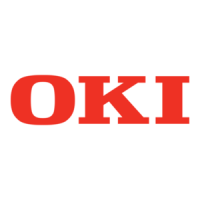
Do you have a question about the Oki ML3410 and is the answer not in the manual?
| printhead | 9 pin |
|---|---|
| print speed at 10 cpi | HSD 550 cps, Utility 417 cps, NLQ 104 cps |
| graphics resolution | 1445216 dpi maximum |
| paper weight | 12 to 24 lb |
|---|---|
| paper thickness top feed | 0.36 mm (0.014 inches) maximum |
| paper thickness bottom feed | 0.50 mm (0.020 inches) maximum |
| operating temperature | 50 to 104 degrees F (10 to 40 degrees C) |
|---|---|
| storage temperature | 14 to 122 degrees F (-10 to +50 degrees C) |
| humidity | 20 to 80% RH |
| voltage | 120 volts, +5.5%/-15% 220/240 volts, ±10% |
|---|---|
| frequency | 50/60 Hz, ±2 Hz |
| power idling | 30 watts |
| power operating | 75 watts |
| width | 25-1/4 inches (540 mm) |
|---|---|
| depth | 19 inches (483 mm) |
| height | 15 inches (203 mm) |
| weight | 63 lbs. (25.4 kg) |
Unpacking the printer and verifying all included items are present.
Minor tasks to perform after unpacking the printer.
Instructions for removing shipping restraints located under the printhead.
Procedure for attaching the platen knob to the printer shaft.
Steps for unpacking and installing the printer ribbon cartridge.
Connecting the power cable and interface cable to the printer.
Guidance on selecting and connecting either a parallel or serial interface.
Guide for installing the separate bottom feed tractor unit.
Information about the optional pull tractor for specialized bottom feed applications.
Guide for installing the optional Cut Sheet Feeder (CSF).
Instructions for loading paper into the optional Cut Sheet Feeder.
How to switch between bins on the dual-bin CSF 3002.
Guidelines for printing envelopes using the Cut Sheet Feeder.
How to adjust the head gap for different paper types and thicknesses.
Instructions for running built-in printer tests to verify functionality.
Overview of standard paper handling configurations for the printer.
Step-by-step guide for loading continuous forms using the rear feed.
Instructions for loading continuous forms using the bottom feed.
How to use the Form Tear Off feature for continuous forms.
Procedure for loading single sheets of paper into the printer.
How to set the top of form position for accurate page alignment.
Instructions for switching between continuous forms and single sheets.
Introduction to the printer's control panel and its functions.
Explanation of the basic control panel lights and their meanings.
Description of the printer's normal operation mode and button functions.
How to select different print quality levels like HSD, Utility, Courier, and Gothic.
How to select character pitch and proportional spacing.
Introduction to customizing printer defaults and features.
Steps to enter the Menu Select mode using control panel buttons.
How to leave the Menu Select mode by pressing the EXIT button.
Explanation of menu structure: groups, items, and settings.
Guide to navigating and making selections within the printer's menu system.
Introduction to controlling the printer via computer, including MS-DOS commands.
Overview of controlling the printer using DOS commands.
Details on PRINT, TYPE, and COPY commands for printing text files.
Detailed explanation and example of the PRINT command for background printing.
How to use the TYPE command with output redirection to print files.
How to use the COPY command to transfer text files to the printer.
Instructions for specifying default printer ports using MODE commands.
Using LPRINT and PRINT# commands in BASIC for printer output.
Lists groups, items, and settings for the Epson/IBM emulation mode.
Parameters for Rear Feed: Line Spacing, Form Tear Off, Skip Over Perforation, Page Width, Page Length.
Parameters for Bottom Feed and Top Feed: Line Spacing, Page Width, Page Length.
Parameters for Set-Up: Graphics, Max. Receive Buffer, Paper Out Override, Print Registration.
Settings for Operator Panel Function, Reset Inhibit, Print Suppress Effective, Auto LF, CSF Bin Select.
Parameters for Parallel and Serial Interfaces: Buffer Print, Pin 18, Auto Feed XT, Parity, Protocol.
Settings for Diagnostic Test, Busy Line, Baud Rate, DSR/DTR Signals, Busy Time.
ASCII, Decimal, and Hexadecimal codes for horizontal printer control.
Codes for Left/Right Margin Set, Auto Justification, Print Direction, Backspace, Delete.
Codes for Line Spacing, Line Feed, Form Feed, Vertical Tab.
Codes for Vertical Format Unit, Vertical Tab Channel, Form Length, Skip Over Perforation.
Codes for selecting and defining character sets, including custom and foreign sets.
Codes for Bar Codes, Utility/NLQ, High Speed Draft, NLQ Typeface, Proportional Spacing.
Codes for character pitch, italics, underlining, subscript/superscript, emphasized printing.
Codes for double width/height printing and various graphics modes.
Codes for Quadruple Density Graphics, 9-Pin Graphics, Reassign Graphics Code.
Codes for Composite Command, Initialize, Cancel, 8th Bit settings, Print Suppress.
Codes for Print Suppress Mode Off, Paper-Out Sensor control, Half-Speed Printing, Software I-Prime.
Commands for selecting NLQ Courier, Sans Serif, Utility, High Speed Draft, emphasized, and enhanced printing.
Commands for character size, underlining, superscript/subscript, and incremental character spacing.
Commands for selecting character sets, setting margins, and indenting.
Commands for setting tab stops, loading vertical format units, and advancing tabs.
Commands for line spacing, form feed, top of form, and miscellaneous functions.
Commands for entering graphics print mode and setting graphics density.
Commands for composite graphics modes, text line feeds, and composite commands.
Commands for carriage return, horizontal tabs, and setting tab spaces.
Commands for vertical tabs, loading vertical format units, and page length.
Commands for NLQ, Utility, character pitch, and double-width printing.
Commands for setting graphics density, entering graphics print mode.
Commands for cancel, suppress mode, bell, and graphics line feeds.
Explains signals from the printer's end for making a serial cable.
Diagrams for IBM 25-Pin and 9-Pin cable configurations.
Details on the Centronics-equivalent parallel cable and printer receptacle.
Summary of printer head, speed, emulations, fonts, interface, and buffer size.